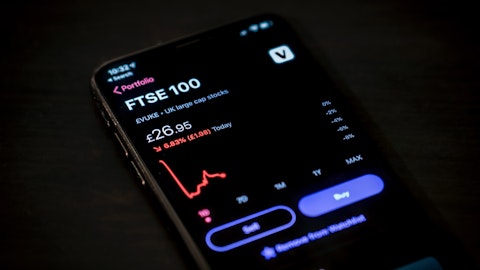Sid Thacker: And I think the one important clarification to my — to the answer to the earlier question is that on marketing, we do not at this point expect to have any changes in marketing spend for fiscal 2024. So we do not expect to reduce our fixed cost reduction plans, do not involve reductions in marketing spend. In fact, as we pointed out earlier, we want to expose more people to a significantly improved experience in fiscal 2024.
Juliana Duque: Got it. Thank you so much.
Operator: Thank you. Our next question comes from the line of Lauren Schenk with Morgan Stanley. Please proceed with your question.
Nathan Feather: Hey. Thanks for taking my question. This is Nathan Feather on for Lauren. On the purchase rate for resale being a 50% year-over-year, what have really been the key drivers moving that up and then any plans or how are you thinking about driving that up further in fiscal 2024? And then as you transition to greater depth across the inventory base, how are you using resale as a method, if at all, to kind of trim that existing lower depth inventory? Thank you.
Jennifer Hyman: Yeah. So number one, we’ve seen a lot of success that as the selection has become more attractive to the user, demand to purchase the inventory has gone up. Number two, we’ve gotten even more sophisticated with our pricing algorithms. So we know exactly how to price the inventory so that we’re still selling it profitably, but doing it in a way that is compelling to our user base. I would say that both of those two improvements are within a strategic channel that is really unique to a subscription or rental model. You think about other companies that are selling items that have been worn before. They don’t have the advantage of the fact that our customers always have at least five things at-home in their closets already.
They’ve already worn them. They’ve already experienced them. They’ve already fallen in love with them. So if we’re able to price it at the right price point, both for them and for us, there’s a much higher likelihood that they will convert on that inventory. The other thing that we started to do, quite honestly, is started to tell customers that this was a benefit of their program. So one of the reasons why some of our customers might sign up for a subscription is that they’re busy. They’re professional women. They have kids. They have other things going on. And this is an easier way for them to kind of shop, because they can try things before they buy it. So just by nature of positioning this as a value set of the program is also another benefit.
The last thing I’ll say is that in the past, we used our Try to Buy channel primarily around much older inventory. So inventory that was in our base for two years or three years or four years and kind of when they had it at-home. We have started to really build the muscle around using currencies in inventory as part of our Try to Buy and building replenishment businesses around that inventory. So really understanding that our customers might want to buy, for example, denim from us, and as opposed to just selling it to them and depleting the amount of denim we have on our platform, instead just replenishing that denim with our partners so that we’re both providing a customer value, making money off of the inventory and not depleting the supply of important categories.
Sid Thacker: Yes. I would say there are three things that we think about when we think about resale. The first is, we have now this quarter, this past quarter, actually become quite surgical at looking at category-by-category, brand-by-brand, trying to understand age of inventory, what we can sell that inventory for, how much that matters to our customers and so on. So we’re utilizing some of those lessons to actually drive some good decisions in terms of what we can sell to whom. The second thing is we have actually made product enhancements to the customer experience and to the technology backbone here where we can target specific items that customers have at-home and convince them to try that item and perhaps buy it if they like it.
And then the third thing is you’ve got to remember all of this, this year has been about making sure that the inventory experience for our customers and the in-stock rate is in good shape. So what we want to also make sure is we protect that. So all of this increase in resale has been essentially dovetailed at the same time with a real protection of the in-stock rates that our customers are experiencing and so we are working on a replenishment type system that ensures that we can not only sell items that customers want, improve loyalty for them, but also, of course, maintain the inventory experience that they are now becoming accustomed to.
Operator: Thank you. Our next question comes from the line of Andrew Boone with JMP Security. Please proceed with your question.
Andrew Boone: Thanks for taking the question. I wanted to ask about promotions. I want to think about [Technical Difficulty]
Jennifer Hyman: Andrew, we can’t hear you. Can you repeat what you were saying?
Andrew Boone: Okay. I wanted to ask about learnings from promotions over the last quarter and how we should think about that as a way to start growth going forward [Technical Difficulty]
Sid Thacker: We couldn’t quite hear you, but if I understand your question correctly, it’s to do with how we’re thinking about promotions going forward. Is that right?
Andrew Boone: And learnings from the last quarter.
Jennifer Hyman: Learnings from the last quarter.
Sid Thacker: Yes. I think what we have seen is — so if you look at the big changes we’ve made, right? We used to have promotions that span several months and we have shrunk those the last quarter to essentially a one-month promotion. We’ve changed some of the promotional pricing for new customers that enter into the program. And what we have found is a fairly encouraging response in terms of our ability to attract customers at price points that don’t involve giving away three months or four months worth of pricing for new customers. Obviously, these are all subject to change. We may decide to bring more people into the program as the experience improves and so on, but I think that what we have learned is that, it isn’t essential to be as promotional as we once were.



